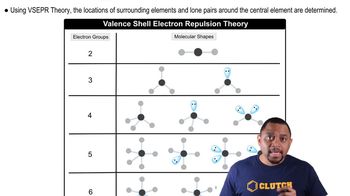Describe the bond angles to be found in each of the following molecular structures: (a) trigonal planar, (b) tetrahedral, (c) octahedral, (d) linear.
Ch.9 - Molecular Geometry and Bonding Theories
Chapter 9, Problem 22
In which of the following molecules can you confidently predict the bond angles about the central atom, and for which would you be a bit uncertain? Explain in each case. (a) H2S, (b) BCl3, (c) CH3I, (d) CBr4, (e) TeBr4.
 Verified step by step guidance
Verified step by step guidance1
Identify the central atom in each molecule.
Determine the number of electron groups around the central atom, including both bonding pairs and lone pairs.
Use VSEPR theory to predict the molecular geometry based on the number of electron groups.
Predict the bond angles based on the molecular geometry.
Consider any deviations from ideal bond angles due to lone pairs or differences in electronegativity.

Verified Solution
Video duration:
6mWas this helpful?
Key Concepts
Here are the essential concepts you must grasp in order to answer the question correctly.
VSEPR Theory
Valence Shell Electron Pair Repulsion (VSEPR) Theory is a model used to predict the geometry of individual molecules based on the repulsion between electron pairs in the valence shell of the central atom. According to this theory, electron pairs will arrange themselves as far apart as possible to minimize repulsion, which helps in determining bond angles and molecular shapes.
Recommended video:
Guided course

Molecular Shapes and VSEPR
Hybridization
Hybridization is the concept of mixing atomic orbitals to form new hybrid orbitals that can accommodate the bonding pairs of electrons. The type of hybridization (e.g., sp, sp2, sp3) influences the geometry and bond angles of a molecule, as it determines how many orbitals are involved in bonding and their spatial arrangement.
Recommended video:
Guided course

Hybridization
Lone Pairs and Bond Angles
Lone pairs of electrons can affect bond angles in a molecule because they occupy space and exert repulsive forces on bonding pairs. This can lead to deviations from ideal bond angles predicted by VSEPR Theory. Understanding the presence and influence of lone pairs is crucial for accurately predicting molecular geometry and bond angles.
Recommended video:
Guided course

Bond Angles
Related Practice
Textbook Question
1070
views
Textbook Question
(b) An AB4 molecule has two lone pairs of electrons on the A atom (in addition to the four B atoms). What is the electron-domain geometry around the A atom?
1283
views
Textbook Question
Would you expect the nonbonding electron-pair domain in NH3 to be greater or less in size than the corresponding one in PH3?
1
views
Textbook Question
Give the electron-domain and molecular geometries for the following molecules and ions: a. HCN
3
views
Textbook Question
Give the electron-domain and molecular geometries for the following molecules and ions: c. SF4
2
views
Textbook Question
Draw the Lewis structure for each of the following molecules or ions, and predict their electron-domain and molecular geometries: (e) XeF2
648
views
